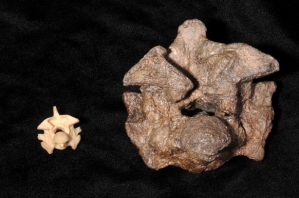In the year of Darwin, I’m not too surprised at the number of articles being published on the interactions between cultural change and biological evolution — this synthesis, if achieved, will certainly be a crucial step in explaining how humans evolved. Still, it’s unlikely we’re going to see the Darwin of culture in 2009, given we’re still disputing some of the fundamentals surrounding these two modes of evolution. One of these key arguments is whether or not culture inhibits biological evolution. That we’re seeing accelerated changes in the human genome seems to suggest (for some) that culture is one of these evolutionary selection pressures, as John Hawks explains:
Continue reading “How do biology and culture interact?”
Tag: biology
Titanoboa… OMG!
If you think this snake is big…

… Then quickly get acquainted with the new (or old?) champ, Titanoboa:

Dramatic name. Dramatic find. Let’s just put it this way: this snake would eat the motherf**king plane. See Ed Young’s or PZ Myers’ accounts for more information.
Orangutans – probably more interesting than you
![]() In the past few years there has been a recent spate of articles concerning orangutan intelligence. So, as I’m fairly bored, and in need of a break from university work, I’ve decided to write a bit of an essay on some of these finds.
In the past few years there has been a recent spate of articles concerning orangutan intelligence. So, as I’m fairly bored, and in need of a break from university work, I’ve decided to write a bit of an essay on some of these finds.
Orangutans… They’re orange, right?
Correct; but Pongo pygmaeus abelii are so much more than just some arboreal orange ape that eats a lot of fruit. In fact, these great apes, the last surviving members of the genus Pongo, are highly resourceful and intelligent creatures, as evident in their ability to make and use tools, perform calculated reciprocity and even whistle a tune.
Continue reading “Orangutans – probably more interesting than you”
